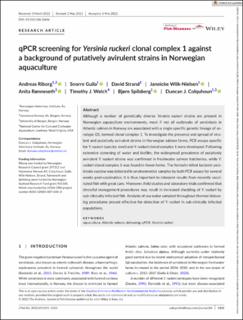| dc.contributor.author | Riborg, Andreas Ekroll | |
| dc.contributor.author | Gulla, Snorre | |
| dc.contributor.author | Strand, David | |
| dc.contributor.author | Wiik-Nielsen, Jannicke | |
| dc.contributor.author | Rønneseth, Anita | |
| dc.contributor.author | Welch, Timothy J. | |
| dc.contributor.author | Spilsberg, Bjørn | |
| dc.contributor.author | Colquhoun, Duncan John | |
| dc.date.accessioned | 2023-03-31T09:30:35Z | |
| dc.date.available | 2023-03-31T09:30:35Z | |
| dc.date.created | 2022-09-02T13:50:11Z | |
| dc.date.issued | 2022 | |
| dc.identifier.issn | 0140-7775 | |
| dc.identifier.uri | https://hdl.handle.net/11250/3061366 | |
| dc.description.abstract | Although a number of genetically diverse Yersinia ruckeri strains are present in Norwegian aquaculture environments, most if not all outbreaks of yersiniosis in Atlantic salmon in Norway are associated with a single specific genetic lineage of serotype O1, termed clonal complex 1. To investigate the presence and spread of virulent and putatively avirulent strains in Norwegian salmon farms, PCR assays specific for Y. ruckeri (species level) and Y. ruckeri clonal complex 1 were developed. Following extensive screening of water and biofilm, the widespread prevalence of putatively avirulent Y. ruckeri strains was confirmed in freshwater salmon hatcheries, while Y. ruckeri clonal complex 1 was found in fewer farms. The formalin-killed bacterin yersiniosis vaccine was detected in environmental samples by both PCR assays for several weeks post-vaccination. It is thus important to interpret results from recently vaccinated fish with great care. Moreover, field studies and laboratory trials confirmed that stressful management procedures may result in increased shedding of Y. ruckeri by sub-clinically infected fish. Analysis of sea water sampled throughout thermal delousing procedures proved effective for detection of Y. ruckeri in sub-clinically infected populations. | en_US |
| dc.language.iso | eng | en_US |
| dc.publisher | Wiley | en_US |
| dc.rights | Attribution-NonCommercial-NoDerivatives 4.0 Internasjonal | * |
| dc.rights.uri | http://creativecommons.org/licenses/by-nc-nd/4.0/deed.no | * |
| dc.title | qPCR screening for Yersinia ruckeri clonal complex 1 against a background of putatively avirulent strains in Norwegian aquaculture | en_US |
| dc.type | Journal article | en_US |
| dc.type | Peer reviewed | en_US |
| dc.description.version | publishedVersion | en_US |
| dc.rights.holder | Copyright 2022 The Author(s) | en_US |
| cristin.ispublished | true | |
| cristin.fulltext | original | |
| cristin.qualitycode | 2 | |
| dc.identifier.doi | 10.1111/jfd.13656 | |
| dc.identifier.cristin | 2048333 | |
| dc.source.journal | Journal of Fish Diseases | en_US |
| dc.source.pagenumber | 1211-1224 | en_US |
| dc.identifier.citation | Journal of Fish Diseases. 2022, 45 (8), 1211-1224. | en_US |
| dc.source.volume | 45 | en_US |
| dc.source.issue | 8 | en_US |

